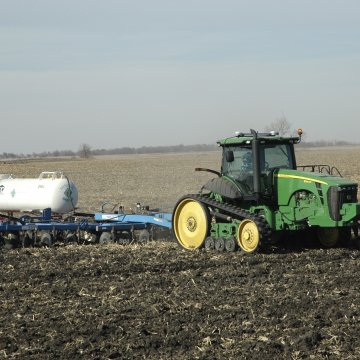
Fertilizer supplies, prices remain low and stable amid coronavirus concerns
As demand increases, though, fertilizer prices will likely rise.
by Gil GullicksonIf there’s a bright spot for farmers from COVID-19, it’s that fertilizer supplies are secure, and prices are competitive.
“Farmers are getting the fertilizer they need, and prices are at a very low level,” says Rick McLellan, senior vice president-commercial for The Mosaic Company.
Whether future fertilizer prices remain low hinges on supply and demand, he adds.
P and K Supplies
Phosphate (P) supplies are being aided by new technologies to extract previously unavailable phosphate. “From 2010 to 2019, global phosphate production has increased 11 million tons per year, from 60 million to 71 tons per year,” McLellan says.
Prices may rise eventually, though, due to factors like slowing Chinese phosphate exports.
“Chinese exports have been quite large and growing over the last 15 to 20 years,” McLellan says. “However, with new environmental regulations taking effect in China, we expect exports to stabilize or fall over the next few years.”
Global potash (K) production from 2010 to 2019 has increased 12 million tons annually, from 52 million to 64 million tons. Two large projects — one in Saskatchewan and another in Russia — have increased supplies and pressured K prices downward.
Supplies also have been boosted by the increasing efficiency of farmers applying fertilizer. “We are getting more out of less than we did 20 years ago,” says McLellan.
In some areas, though, farmers use more P and K. Use of starter fertilizers containing P and K has been boosted by farmers using them outside of traditional starter fertilizer states like Minnesota, North Dakota, and South Dakota. For example, Brazilian farmers are adopting the banding of P and K at planting, says McLellan.
Since the only advance markets for P and K are lightly traded paper markets, it’s difficult for farmers to lock in future P and K supplies. However, if their fields need it this year, current low prices represent a good opportunity to rebuild P and K levels.
“Low prices will not stay forever, just like high prices, ”McLellan says.
Nitrogen
The crash in global energy prices keyed by COVID-19 has also translated into declining nitrogen (N) prices, says Scott Boyd, director-Western U.S. with Koch Fertilizer.
“There is an entire energy complex that has come under pressure as a result of the global and domestic economy shutting down,” says Boyd. “Energy costs are variable costs for making nitrogen products.”
Until global energy prices snap back, N prices will have difficulty rebounding, he says.
Buoying up demand is the fact that since N is a mobile element, farmers need to apply it every year on crops like corn, says Boyd.
“Its use is more resilient compared with other ag inputs,” he says.
Other uses outside of agriculture also can boost N demand. Urea and anhydrous ammonia are used for making other products like resins, textile scrubbers, and emission scrubbers, says Boyd.
Conversely, global currency fluctuations can nix demand, he says. “In areas of South America, currency depreciation and volatilization create economic uncertainty that can destroy demand,” says Boyd.
Shift Away From Anhydrous Ammonia
Overall, COVID-19 may not impact the stability of global N supplies, says Boyd. “We don’t expect a lot of trade flow shifts as a result of COVID-19,” he adds.
COVID-19 also isn’t anticipated to impact shifts in N forms that have already been occurring for decades.
For example, global anhydrous ammonia use has steadily declined over the past 20 years.
“It’s still a popular form of N for farmers to use, but mainly for those who farm close to production and storage facilities,” he adds.
That’s partially due to a narrowing of anhydrous ammonia application windows by farmers.
“That’s created constraints for the dealer network to keep up,” says Boyd.
Dealers who work with farmers within a 100-mile radius of a plant or storage facility can better manage in-season logistics, but it’s more difficult to be cost-effective outside of a 100-mile radius, he says. Anhydrous ammonia storage and transportation can be upgraded, but it is costly, he adds.
New facilities are being built. Greenfield Nitrogen has plans to commission an anhydrous ammonia plant in Garner, Iowa, capable of churning out 120,815 tons per year.
However, Boyd doesn’t expect many similar plants to be launched in the future, due to capital demands and also due to uncertainty about U.S. natural gas prices.
Sulfur prices have stayed relatively consistent over the past five years, says Boyd. “You don’t see a lot of variability in that market in terms of finished products like ammonium thiosulfate or ammonium sulfate,” he says.
COVID-19’s Production and Distribution Impact
The 2020 spring was smooth from a fertilizer transportation point of view, says Boyd. Regulatory changes helped spur some of this, says Boyd. “Having extra capacity for trucks (via waiving or reducing weight limits) helped,” he says.
Rail lines also have moved product smoothly, says McLellan. “Our initial concerns about customers getting access to trucks has not been an issue,” he adds. “Despite high water levels, barges continue to move.”
Boyd expects COVID-19 to have no major impact on future fertilizer delivery and supplies. However, processes will change.
“There have been some shifts in protocol for trucks coming into terminals, such as maintaining social distancing and cleaning of facilities,” he says.
Koch Fertilizer also uses technology to reduce human contact, such as the LoadView app fertilizer truck drivers can use to check into a Koch plant or terminal before arrival, he says.
“That speeds up the ability (of the driver) to get in a location without the driver having interactions they have used historically,” says Boyd.
To reduce the risk of COVID-19 among production employees, fertilizer firms like Mosaic are incorporating new protocols like temperature checks to detect ill employees, says McLellan. Meanwhile, office personnel have worked out of their homes, using digital tools to keep in touch with their customers.
“Our people have not skipped a beat,” says McLellan.